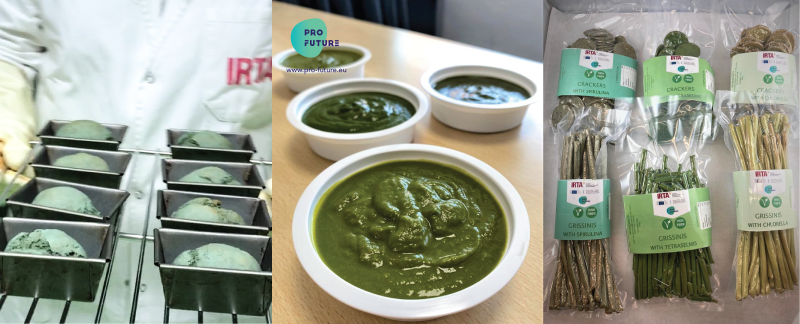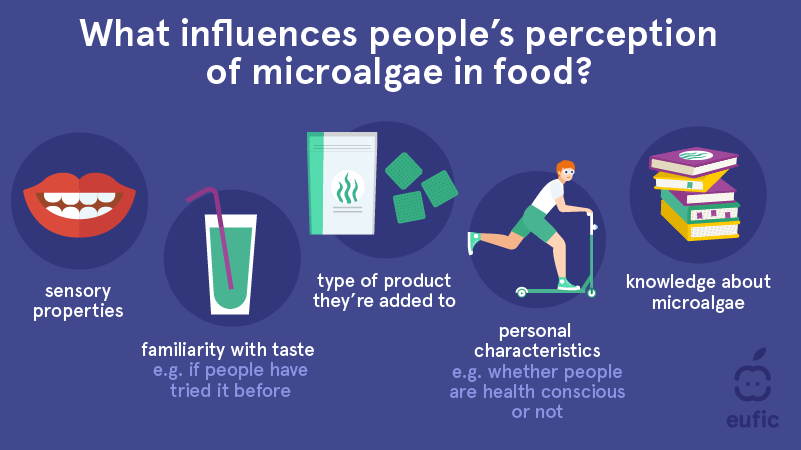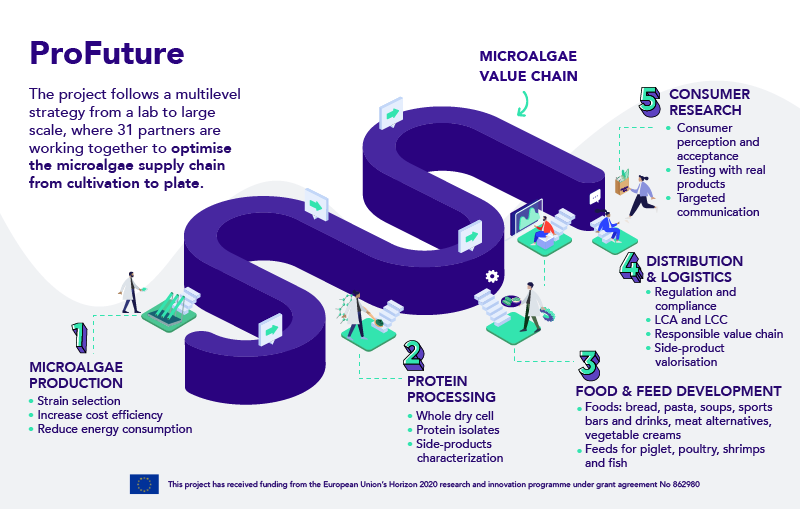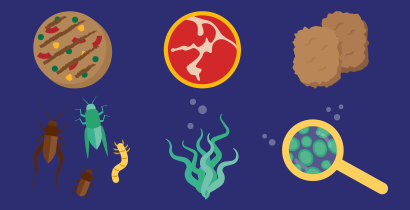Microalgae: producing new food products that consumers accept
Last Updated : 19 April 2022The ocean plays an important role when it comes to securing food and nutrition for many people around the planet today, but it holds even greater potential as part of a sustainable food system in the future. Microalgae have gained increased attention as they present a more sustainable source of protein than other conventional sources, such as livestock. But can these unfamiliar ingredients be used to create new types of high-protein food products, and will people be willing to eat them?
What are microalgae?
Microalgae, also known as phytoplankton, are tiny plant-like microorganisms that live in various aquatic environments where they form the basis for most food chains. They first appeared on earth over one billion years ago, making them one of the oldest species of life. Microalgae are usually made from one single cell or a small number of cells put together in a very simple structure which can quickly grow and multiply into a large biomass rich in nutrients. Microalgae come in different shapes and colours and can be used for different industrial purposes from food and feed to cosmetics and biofuel production. Some of the more well-known microalgae species include Spirulina and Chlorella which are used in food supplements.
Microalgae in food products
Microalgae have great potential to be used as ingredients in innovative and sustainable food and animal feed products. Microalgae are beneficial as a food source because in addition to having a high protein content, they also contain valuable nutrients such as phenolic compounds, vitamins and minerals.
Using microalgae as food is still quite uncommon for many people in Europe, and if they are to live up to their potential, it’s interesting to find out how new microalgae products are welcomed by consumers. It is a complex challenge to try to produce new food products with improved nutritional properties without affecting sensory qualities such as taste and texture that may stop people from enjoying them. Some examples of microalgae-enriched foods that are currently being developed include:
- Microalgae-enriched bread has potential to be more nutrient-dense than a regular bread thanks to the added protein and other nutrients. However, adding microalgae to bread and achieving a product that is pleasing to all five senses presents some challenges. Replacing as little as 3% of the flour with Spirulina, has visible effects on the volume, texture, colour and taste of the bread. Adding Spirulina powder to the dough makes bread smaller and lighter with green tonalities. Taste tests on these breads show that people are generally positive about the colour and marine taste.
- Vegetable creams are becoming more and more popular thanks to the increased demand for healthy products. Vegetable creams enriched with microalgae have a high protein content, and some new recipes meet the criteria to be labelled as having “high-protein content” following the current EU legislation. This is good news for many consumers who are looking for healthy products with more sustainable protein.
- Snacks containing microalgae, such as muffins, grissini and crackers, are also being explored with the aim of having both a higher protein content and increased antioxidant activity than their conventional counterparts. Adding microalgae to these products does not change the texture much from the standard products, but they do have a more greenish colour. Studies so far show that these products have a good level of acceptance by people despite the unusual colours.

These food products are being developed and tested as part of the EU-funded project ProFuture. Read more about how researchers are developing these fortified breads and snacks.
Consumer perceptions of microalgae in food
There are several different factors influence how people perceive microalgae in food, including:
- Sensory properties: When microalgae are added to food, they may change the food’s colour and taste, which is usually perceived as negative by consumers. This may be the reason why products with added microalgae are not on the market in large numbers. [1]
- The “carrier product”: The food product to which the microalgae are added, is called the “carrier product”. The type of carrier product plays an important role in how added microalgae is perceived. For example, people are more likely to like microalgae in pasta than in products like milk and bread. [2, 3]
- Familiarity with the taste: People who are already familiar with the taste of microalgae, for example Spirulina, are less likely to be disappointed with the taste of microalgae in food products. [4]
- Knowledge about microalgae: There are differences between how people from different countries perceive microalgae food products. Researchers have observed that French consumers are more positive towards microalgae in their food than German consumers. This may be linked to a generally higher knowledge about microalgae in the French population than in the German population. [4]
- Personal characteristics: Health-conscious individuals seem to be more willing to accept food products with added microalgae [5, 6], while so far concerns about the environment do not seem to influence people’s opinions about microalgae in food products, despite their potential as a more environmentally sustainable source of protein. [7]

The bigger picture of ProFuture – steps to consider within the microalgae value chain
The work described in this article is part of a project called ProFuture, a European-funded Horizon 2020 research project aiming to scale up microalgae production and prepare the market uptake of microalgae proteins as ingredients for innovative and sustainable food and feed products.
The ProFuture project does not only involve the work around consumer perceptions of microalgae in food, it actually involves the whole microalgae value chain. This means that the work does not end with the new products, as other ProFuture partners work on areas like increasing the cost-efficiency and sustainability of large-scale cultivation of microalgae, regulatory aspects (as in some cases microalgae are considered a novel food and must be legally accepted), the environmental impact (LCA), and preparing for a successful market uptake of these new products. All of these aspects are important when introducing microalgae as a sustainable part of our diet.

 This article was produced in collaboration with ProFuture. ProFuture has received funding from the European Union’s Horizon 2020 Research and Innovation programme under Grant Agreement No. 862980.
This article was produced in collaboration with ProFuture. ProFuture has received funding from the European Union’s Horizon 2020 Research and Innovation programme under Grant Agreement No. 862980.
References
- Beheshtipour, H., et al., Supplementation of Spirulina platensis and Chlorella vulgaris Algae into Probiotic Fermented Milks. Comprehensive Reviews in Food Science and Food Safety, 2013. 12(2): p. 144-154.
- Cox, D.N., G. Evans, and H.J. Lease, The influence of product attributes, consumer attitudes and characteristics on the acceptance of: (1) Novel bread and milk, and dietary supplements and (2) fish and novel meats as dietary vehicles of long chain omega
- Grahl, S., et al., Consumer-Oriented Product Development: The Conceptualization of Novel Food Products Based on Spirulina (Arthrospira platensis) and Resulting Consumer Expectations. Journal of Food Quality, 2018. 2018: p. 1919482.
- Grahl, S., et al., Alternative protein sources in Western diets: Food product development and consumer acceptance of spirulina-filled pasta. Food Quality and Preference, 2020. 84: p. 103933.
- Urala, N. and L. Lähteenmäki, Attitudes Behind Consumers' Willingness to use Functional Foods. Food Quality and Preference, 2004. 15: p. 793-803.
- Verbeke, W., Functional Foods: Consumer Willingness to Compromise on Taste for Health? Food Quality and Preference, 2006. 17: p. 126-131.
- Moons, I., C. Barbarossa, and P. De Pelsmacker, The Determinants of the Adoption Intention of Eco-friendly Functional Food in Different Market Segments. Ecological Economics, 2018. 151(C): p. 151-161.
- Van der Stricht, H., Set-up and planning of the ProFuture consumer survey. 2021.

